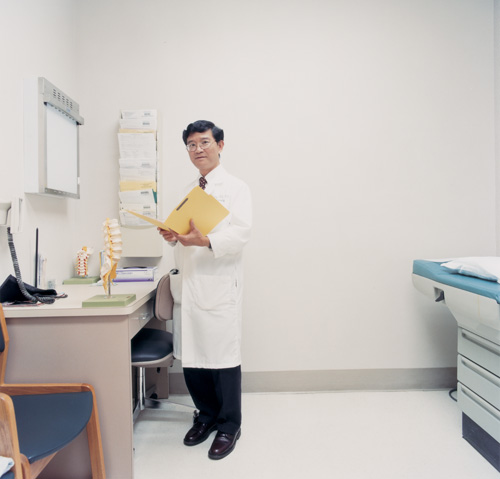A baby-killing disease meets its match
Misty Keasler |
|
 |
|
By KRISTA CONGER
“Hi, Dr. Wang.” The first words of a young child have a special sweetness — a blend of promise and expectation. But some voices are more precious than others.
“She said my name,” marvels Ching H. Wang, MD, PhD. “It’s one of the only times I’ve heard a child with this condition speak.”
The pediatric neurologist and researcher sorely needed a boost. Earlier that morning in October he’d received the phone call that every pediatrician dreads: one of his patients had died the day before.
The news had a familiar ring. Wang, who is director of Lucile Packard Children’s Hospital’s neuromuscular disorders clinic and an associate professor of neurology and pediatrics at the School of Medicine, specializes in treating children with spinal muscular atrophy, or SMA. Although most people have never heard of it, the disorder is the leading genetic cause of death of children under the age of 2 in this country. Wang’s set on curing it.
About 1 in 10,000 children are born missing a gene that codes for a protein needed to maintain the spinal nerves that control voluntary movement. Those with the most severe form of SMA, called type 1, rarely roll over and never sit up by themselves. They usually die from respiratory failure before they’re 1 year old. People diagnosed later in life usually have milder symptoms and are classified as types 2 or 3. Although intelligence is unaffected by SMA, people with type 1 rarely speak; they don’t live long enough. That is, until now.
“Things are happening that aren’t supposed to be happening in our patients,” says Wang, who is leading a clinical trial of an SMA treatment — one of the first for children with the disorder.
Legions of pediatricians have committed in similar ways to help children live healthier, longer lives. Many times this means speaking up for children whose own voices have been silenced by disease or are unheard over the roar of competing interests. Advocacy by pediatricians and parents is crucial to divert funding and legislative attention that predominantly flows to diseases that affect vocal, voting and sometimes very well-known adults. Amyotrophic lateral sclerosis, for example, became known as Lou Gehrig’s disease in 1939 when the famous baseball player was diagnosed. And public awareness of spinal cord injuries and Parkinson’s disease has rocketed in the past few years due to afflicted celebrities like Christopher Reeve and Michael J. Fox. Children don’t have the same influence.
“Pediatric SMA patients never live to be stars,” says Wang bluntly.
Stars or not, they leave their mark. Wang still can’t forget a 4-month-old baby with SMA who died in the intensive care unit while he stood by helplessly 15 years ago. He was a pediatric neurology fellow at Columbia University at the time.
“Her death was devastating,” Wang says. “She turned blue and died right in front of me. I decided then that I had to do something about this.” Before his fellowship ended he had joined scientists in T. Conrad Gilliam’s lab at Columbia trying to ferret out the molecular cause of SMA.
“At that point we didn’t have a clue about the pathogenesis of the disease,” says Wang. “Kids just died.” Within months, however, Gilliam’s group had identified a region on chromosome 5 that was often missing in SMA patients. Five years later, another research group, with Wang and Gilliam hot on their heels, homed in on the critical gene, naming it survival motor neuron, or SMN. “Without the protein made by this gene, motor neurons in the spinal cord die,” says Wang.
One reason SMN led the researchers on such a merry chase is that it occurs in two versions in a healthy person’s genome, SMN1 and SMN2 — and SMN1 is far better at generating a fully functional version of the protein. SMA patients nearly always lack a functional SMN1 gene, and their SMN2 genes fail to produce enough SMN protein to fully sustain the spinal cord motor neurons. Variations among patients in their SMN2 genes’ effectiveness account for the differences in severity recognized by the classification types.
Misty Keasler |
|
 |
|
Faint cries
“She’s a little limp,” commented the photographer as he tried to position 6-week-old Aleena Hope Miller for her first professional photos in March 2004. Aleena’s mom, Stephanie, was worried. The Georgia woman had recently noticed that her perfectly healthy newborn had begun coughing and had stopped sucking her thumb. She and her husband, Aaron, hoped their concern was just a symptom of first-time parenthood, but they made a doctor’s appointment.
Aleena’s pediatrician noticed that her cry was faint and her legs were weak. He arranged for them to meet a neurologist that night in an Atlanta emergency room.
“The neurologist said he suspected spinal muscular atrophy,” says Stephanie. “At first we thought, OK, maybe she would be handicapped. But then he said it was life-threatening. It was devastating.”
What the Millers learned after reading about the condition left them with an even bleaker picture.
“‘Your child is not going to live.’ At first I accepted that, I believed that — there it was in print right in front of me,” says Stephanie. But a few days after the diagnosis the Millers began to hope. They found a press release on the Internet that had been issued the week before Aleena’s birth. It described one of the first FDA-approved clinical trials for the treatment of SMA. The head researcher? Dr. Ching Wang.
Hope?
Wang and other SMA researchers had made much progress since the discovery of the SMN genes. They had learned that SMN2’s less-than-stellar performance as a protein-maker stems from its tendency to leave out one essential chunk, or exon, when generating the RNA strand used as the protein template. But about 10 percent of the time the template includes the exon and generates enough functional protein to keep a child without SMN1 alive, if only for a few months. Wang showed that, in people missing SMN1, the ratio of full-length to shortened SMN RNA correlated with the severity of the disease’s symptoms: people with more long than short fared much better than people with more short than long.
“It was quite exciting,” says Wang. “I saw the result and knew right away that if we could coax SMN2 to generate more functional protein, we could have the key to a cure right there.”
Wang advanced this idea at an international SMA meeting in 1996 while other researchers were discussing how to use gene therapy to produce the full-length protein.
“I stood up and said ‘Look, we already have a copy of the gene there in the DNA. I think we can do something about this disease if we can make this spare copy work like the real one.’ They all just looked at me thoughtfully.”
They took his words to heart and began searching for ways to increase the expression of the functional protein in cells from people with the disease. Many candidate drugs had drawbacks: either they were difficult to administer orally, they were toxic or too little was known about their safety in humans. There remained one compound to try — a drug called hydroxyurea, which can increase the expression of some genes. It’s used to treat blood diseases like sickle cell anemia and thalassemia.
When Wang tested hydroxyurea’s effect on cells from SMA patients, he found that the drug significantly increased the expression of the functional protein.
The results were so encouraging that Wang applied for and received FDA approval to begin clinical trials using hydroxyurea in children with type-1 and type-2 SMA. In June 2004, Aleena became the fourth type-1 child to enroll in the trial.
Aleena’s health deteriorated during the initial double-blind phase of the trial, which lasted six months. She lost her ability to swallow and move her arms and suffered through pneumonia and two collapsed lungs. Although neither Wang nor the Millers know if Aleena received hydroxyurea in that phase, Stephanie and her husband noticed an immediate improvement when Aleena went on the drug in January 2005 as part of the open-label phase of the trial.
“Her left leg started to rotate, and she was pushing with her feet,” says Stephanie. “Her arms became stronger, and she could turn her head a bit. She also needed less help breathing and was less likely to choke.”
Although it’s too soon to make a definitive conclusion about the trial’s outcome, at 23 months Aleena was beating the odds. Says Stephanie: “By all accounts she should not be here right now.”
Aleena’s not just hanging on — she’s starting to speak. She’s limited to a few words now: mama, daah and love. But her parents and Wang hope for a day when her voice cuts through the clamor of her classmates to answer a teacher’s question or reports excitedly on the day’s events.
Meanwhile, SMA’s getting more attention: in 2004, the National Institute of Neurological Disease and Stroke launched the Spinal Muscular Atrophy Project to develop additional drug candidates, some of which may be more effective or more specific than hydroxyurea.
“Big pharmaceutical companies are now involved, screening hundreds of thousands of drug compounds that might make SMN2 work like SMN1,” says Wang. “I’m very hopeful that there will be a cure for SMA one day.”
Comments? Contact Stanford Medicine at

